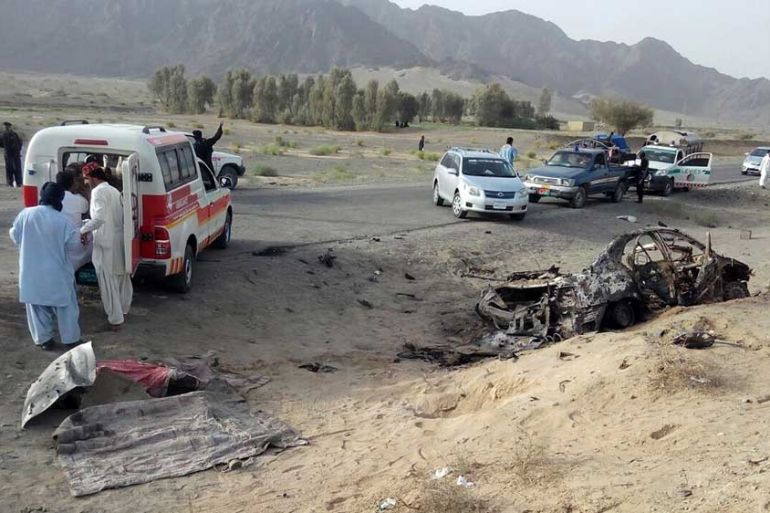Obama says Afghan Taliban’s Mullah Mansoor dead
US president calls apparent death an “important milestone” after several drones attack Mansoor’s car in Pakistan.

United States President Barack Obama has said that the Afghan Taliban leader Mullah Akhtar Mansoor was killed in a US strike.
In a statement on Monday, he called Mansoor’s death an “important milestone”.
“We have removed the leader of an organisation that has continued to plot against and unleash attacks on American and Coalition forces, to wage war with the Afghan people, and align itself with extremist groups like al-Qaeda,” he said.
Afghanistan’s Chief Executive Abdullah Abdullah said on Twitter a day earlier that Mansoor was dead, the country’s spy agency also said he had been killed and a source close to Mansoor told Al Jazeera he believed the reports to be true.
The Taliban has not yet issued an official statement, though some of the group’s officials earlier denied the reports.
PROFILE: Mullah Akhtar Mansoor
Obama, who authorised the attack, was in Vietnam for his first state visit when the statement was issued.
Speaking at a news conference following his meeting with Vietnamese President Tran Dai Quang, Obama said the fatal attack on Mansoor did not represent a change in US military strategy in Afghanistan, which is to help train Afghan forces. Obama ended the US combat mission in Afghanistan in 2014.
“We are not re-entering the day-to-day combat operations that are currently being conducted by Afghan security forces,” Obama said. “Our job is to help Afghanistan secure its own country, not to have our men and women in uniform engage in that fight for them.”
US forces in Afghanistan
Mansoor was chosen to head the Afghan Taliban last summer after it was announced that the group’s previous leader Mullah Omar had died two years earlier.
The Taliban is the most powerful armed group in the country, where an estimated 11,000 civilians were killed or wounded and 5,500 government troops and police officers died last year alone.
It seized power in 1996 and ruled Afghanistan until it was toppled by a US-led invasion after the September 11, 2001, attacks on New York and Washington.
Almost 15 years later, about 13,000 troops are in the country from a US-NATO coalition, including about 9,800 Americans.
While they are mostly focused on training and helping Afghan government forces battle the insurgency, about 3,000 troops are conducting operations against the Taliban and groups including al-Qaeda and the Islamic State of Iraq and the Levant (ISIL, also known as ISIS).
Who is Mullah Akhtar Mansoor?
- Mullah Mansoor was born in around 1965 in a small village called Kariz in the Maiwand district of Kandahar. He belongs to Afghanistan’s Ishaqzai tribe.
- He fought against Soviet forces in Afghanistan for a brief period and was a member of Harakat-i-Inqilab-i-Islami, a former paramilitary group formed by Maulana Mohammad Nabi Mohammadi to fight them.
- One of his first jobs for the group was overseeing the security of Kandahar airport.
- In 1996-2001, when the Taliban was in power, he oversaw the ministry of civil aviation.
- He rose to the upper echelons after Mullah Akhtar Osmani, a senior Taliban military leader and a close associate of Mullah Omar, was killed by US-led coalition forces in 2006 and Mullah Dadullah Akhund, the group’s top military commander, was killed in 2007 by British special forces.
- Between 2007 and 2010 he was able to stake a claim for higher office when Mullah Abdul Ghani Baradar, the deputy of Mullah Omar, and Mullah Obaidullah Akhund, the Taliban government defence minister, were captured by the Pakistan Intelligence agency ISI.
- In July 2015, Afghan intelligence said that Mullah Omar had been dead for two years. Within hours of that announcement, the Taliban reportedly held a meeting and elected Mullah Mansoor as leader. But his appointment appeared to expose fissures in the group.
- A few months after his appointment, Taliban fighters seized the capital of Kunduz province after launching a daring raid from multiple directions. The attack was the biggest blow to President Ashraf Ghani since he took office a year before.
- In December 2015, Afghan officials said Mansoor had died after a gunfight. The Taliban later released an audio message from him in which he denied he had been killed.
- Mansoor refused to join any of the Quadrilateral Coordination Group (QCG) meetings, made up of representatives from Afghanistan, Pakistan, China and the United States and aimed at reviving a peace process.
- After his persistent refusal to join talks, Afghan officials told Al Jazeera that action against the Taliban would be on the agenda for the fifth round of peace talks in early May.
- US officials briefed the media on May 21 that a drone attack authorised by President Barack Obama had “likely killed” him and another Taliban member.